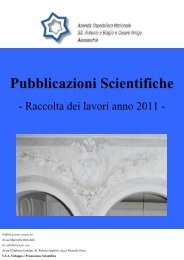Working Paper of Public Health Volume 2012 - Azienda Ospedaliera ...
Working Paper of Public Health Volume 2012 - Azienda Ospedaliera ...
Working Paper of Public Health Volume 2012 - Azienda Ospedaliera ...
Create successful ePaper yourself
Turn your PDF publications into a flip-book with our unique Google optimized e-Paper software.
<strong>Azienda</strong> <strong>Ospedaliera</strong> Nazionale“SS. Antonio e Biagio e Cesare Arrigo”<strong>Working</strong> <strong>Paper</strong> <strong>of</strong> <strong>Public</strong> <strong>Health</strong>nr. 10/<strong>2012</strong>Neuromuscular diseases (Table 3) are an heterogeneous group <strong>of</strong> diseases, but independently fromthe different etiopatogenesis and clinical features have a similar natural history with similar stages<strong>of</strong> evolution. The following conditions are observed in all neuromuscular diseases: a reduction <strong>of</strong>the strength <strong>of</strong> respiratory muscles, a restrictive respiratory syndrome and a deficit <strong>of</strong> cough withstagnation <strong>of</strong> secretions in the airways and consequent atelectasis.3.1 - REDUCTION OF THE STRENGTH OF RESPIRATORY MUSCLESThese patients have a decrease in inspiratory and expiratory muscle strength expressed by lowerpeak inspiratory pressure (MIP) and maximal expiratory pressure (MEP). In spinal cord injurypatient with medium-low level <strong>of</strong> lesion (C4 - C7) the reduction <strong>of</strong> MIP in the acute phase is 64 ±12% but increases about 40% (46 ± 6 to 77 ± 4) within 18 weeks .3.2 - RESTRICTIVE RESPIRATORY SYNDROMEThe reduction in lung volumes measured by spirometry, is mainly due to lack <strong>of</strong> ventilatorypump, but also to the alterations <strong>of</strong> the mechanical properties <strong>of</strong> the chest and to the formation <strong>of</strong>atelectasis. The vital capacity is always reduced. With values <strong>of</strong> vital capacity around 40-50% <strong>of</strong>normal ventilatory pump deficiency becomes constant and particularly during infection isnecessary medical treatment. The inadequacy <strong>of</strong> the ventilatory pump can be maintained orworsened by: Overproduction and stagnation <strong>of</strong> secretions favoured by the deficit <strong>of</strong> expectoration. Increased load and resistance <strong>of</strong> airways. The reduced muscle strength and alteration <strong>of</strong>the elastic properties <strong>of</strong> the respiratory system prevent the achievement <strong>of</strong> adequate lungvolumes after an in-depth. This limits the amount <strong>of</strong> air available to the expulsive phase <strong>of</strong>cough and indirectly causes a decrease in expiratory flow and, in particular, the PCEF. Further reduction <strong>of</strong> lung compliance for the formation <strong>of</strong> atelectasis and infections.In case <strong>of</strong> quadriplegia all lung volumes are reduced, except the residual volume increases byreduction <strong>of</strong> reserve capacity expiratory. The FRC is reduced: this parameter is an expression <strong>of</strong>balance between the opposing elastic forces <strong>of</strong> lungs and chest from which it derives a newequilibrium at lower lung volumes. FEV 1 (maximum expiratory volume per second) is reducedwith values similar to the reduction <strong>of</strong> vital capacity. The stagnation <strong>of</strong> secretions generates anincreased work <strong>of</strong> breathing worsening respiratory mechanics and increasing muscle fatigueleading to a serious deficit in ventilatory pump. Another major complication is represented byatelectasis (mainly in the dorsal lung areas) also in small bronchi <strong>of</strong> the deep lung. The weakness4



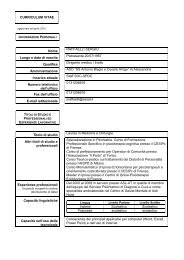
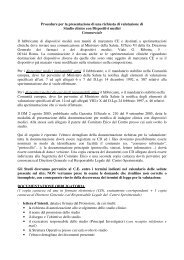

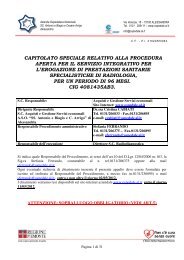
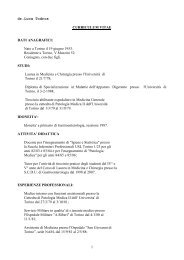
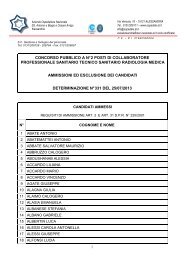

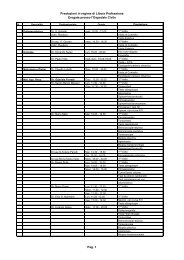


![[torino - 1] lastampa/urc/01 ... 26/10/09 - Azienda ...](https://img.yumpu.com/44058002/1/190x32/torino-1-lastampa-urc-01-26-10-09-azienda-.jpg?quality=85)

